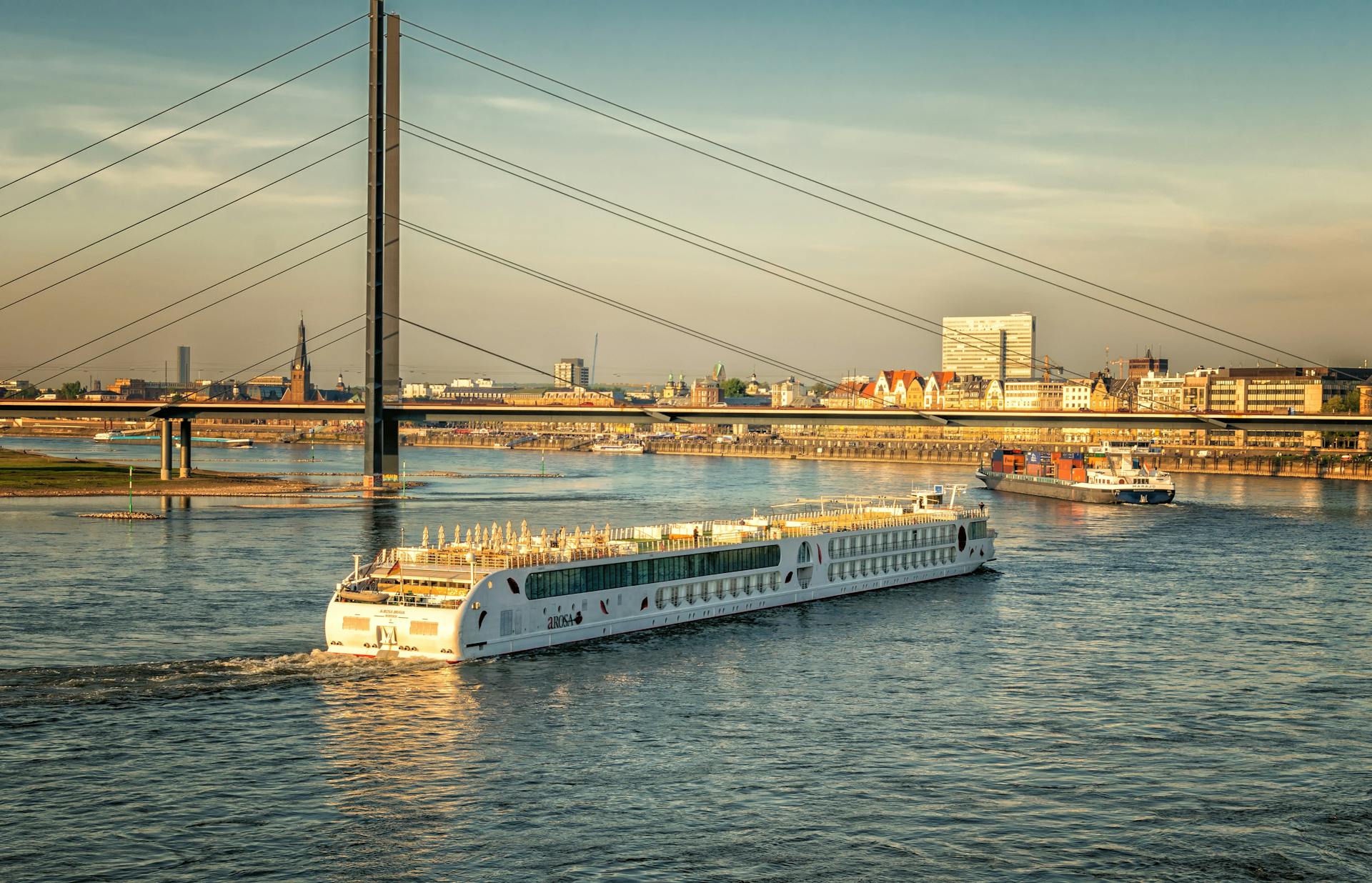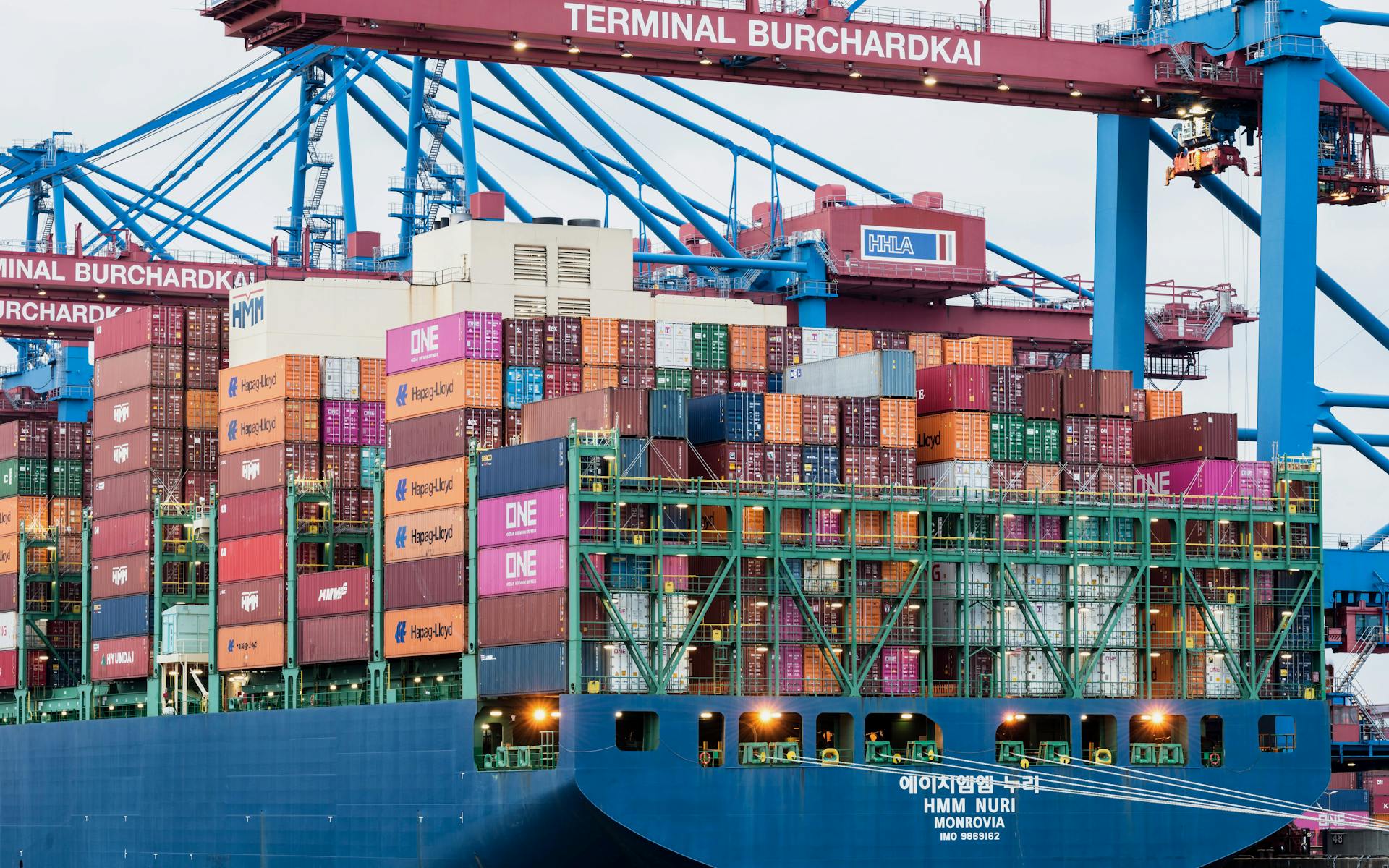
A boat travel lift is a convenient way to move your boat in and out of the water, but have you ever wondered how it works? Boat travel lifts use a combination of hydraulic or pneumatic systems to lift and lower boats.
There are different types of boat travel lifts, including hydraulic and pneumatic systems, with hydraulic systems being the most common type used for larger boats.
Types of Marine Travel Lifts
Marine travel lifts are used to lift and carry boats to their desired place, and there are different types to suit various needs.
Cross travel lifts are commonly used after a boat is moved away from the slip, and they're often combined with a gantry or cranelike structure. This type of lift is perfect for use in a boatyard.
Straddle lifts are a type of travel lift with two parallel verticals that stride over a boat or object to pick it up. They're frequently customized to meet a variety of lifting requirements.
Double gusset hoists provide stability when lifting boats or vessels that require careful handling, offering additional support and resistance from lateral movement.
Here are the different types of marine travel lifts:
- Cross Travel Lifts
- Straddle Lifts
- Double Gusset Hoist
Industry and Applications
Boat travel lifts are used in a variety of industries and applications, including marinas, ship repair yards, and shipyards. They're essential for lifting and transporting boats for maintenance, repairs, and storage.
Marinas rely heavily on travel lifts to lift boats out of the water for routine maintenance and repairs. This is because travel lifts are engineered with superior weight distribution to safely and swiftly transport vessels of all sizes and weights.
Ship repair yards use travel lifts to move boats from the water to dry land for storage and repair work. This is particularly useful for vessels that require extensive repairs or modifications.
In shipyards, larger boat lifts are used to lift commercial vessels out of the water for maintenance and repair work. This is often necessary for vessels that need to undergo major overhauls or upgrades.
Travel lifts are also used in fishing harbors to lift fishing boats out of the water for repairs or to change out gear. This helps to keep fishing boats in top condition and ensures they're safe to operate.
Here are some common application scenarios of boat lift cranes:
- Marinas: Marina travel lifts are commonly used in marinas to lift boats out of the water for maintenance and repair work.
- Ship Repair Yards: Ship repair yards use travel lifts to move boats from the water to dry land for storage and repair work.
- Shipyards: Larger boat lifts are used in shipyards to lift commercial vessels out of the water for maintenance and repair work.
- Fishing Harbors: Boat travel lifts may also be used in fishing harbors to lift fishing boats out of the water for repairs or to change out gear.
- Military Bases: Military bases with maritime operations may use marine travel lifts for maintenance and repair work on their vessels.
- Yacht Clubs: Yacht clubs, which cater to the needs of yacht owners and enthusiasts, have boat travel lifts to assist with launching, retrieving, and maintaining yachts.
Aicrane Travel Lifts
Aicrane Travel Lifts are designed to meet the unique needs of boat handling, with a wide range of lifting capacities from 10 to 1200 tons. This makes them suitable for everything from small recreational boats to large commercial vessels.
Their boat lift cranes can be fully hydraulically driven or fully electric, depending on your requirements. This flexibility is a major advantage when it comes to adapting to different working conditions.
Aicrane offers various running and steering modes, including straight travel, oblique travel, and Ackerman steering. This ensures that their travel lifts can be tailored to suit specific boat handling needs.
Here's a look at the different capacities of Aicrane marine travel lift for sale:
Aicrane's experienced engineers and project consultants work closely with customers to discuss their specific requirements and budget. This ensures that a tailored boat handling solution is provided to meet the unique needs of each project.
Travel Lift Capacities
Aicrane offers a range of travel lifts designed to accommodate various capacities and meet diverse boat hauling requirements.
Light Duty, Mid-Range, and Heavy Duty are the different capacities of Aicrane marine travel lift for sale.
The 25 Ton Boat Lift is a great option for smaller boats, while the 30 Ton Boat Lift and 50 Ton Boat Lift can handle larger vessels.
The 100 Ton Boat Lift is the most heavy-duty option, capable of lifting massive boats.
Aicrane's boat lifts have a rated lifting capacity ranging from 10 to 1200 tons.
Here are some specific lifting capacities:
- 15 metric tons (33,000 lbs. / 15,000 kg)
- 25 metric tons (55,000 lbs. / 25,000 kg)
- 100 Ton Boat Lift
Travel Lift Options and Pricing
The cost of a boat travel lift can vary significantly based on several key factors, including lifting capacity, brand, features, and location.
Lifting capacity is a major factor in determining the price of a boat travel lift, with prices ranging from a few thousand dollars for smaller lifts to tens of thousands of dollars for larger ones.
The brand of the boat travel lift also plays a significant role in determining the final price, with some brands offering more advanced features and higher quality construction at a higher cost.
It's challenging to provide a precise figure without understanding your specific needs and requirements.
Hauling Options
If you're looking for alternatives to a travel lift, there are several options to consider. Trailers, forklifts, and railway systems are all viable options, but they each have their own set of challenges.
Railways are the oldest method of hauling boats, requiring a lot of time and labor to complete a haul and limiting travel to where the track is.
Forklifts are very adaptable and can pick up boats below ground level while still in the water, making them a good option for certain situations.
Travel lifts, on the other hand, provide both negative and positive lift, and can handle a wide range of boat types with ease. They're also available in a variety of sizes, from 50 tons to hundreds of tons.
Self-propelled motorized trailers are another option, designed for fast lifting and handling and ideal for streamlining operations in shipyards, ports, and marinas.
Here are some key characteristics of each hauling option:
- Trailers: require a ramp to launch or remove boats
- Railway systems: require a lot of time and labor, limited to where the track is
- Forklifts: adaptable, can pick up boats below ground level
- Travel lifts: provide negative and positive lift, adaptable to various boat types
- Self-propelled motorized trailers: designed for fast lifting and handling
Mid-Range
If you're in the market for a mid-range travel lift, you've got several options to consider. The 100 ton marine travel lift for sale is a great choice for mid-sized commercial boats or large yachts.
This lift has high lifting capacity with a focus on durability and long-term performance. Its robust design ensures safe and efficient operations.
For larger commercial vessels, the 150 ton travel lift is a top pick. It has robust design to handle demanding lifting tasks, with advanced safety features.
Here's a quick comparison of the mid-range options:
The 200 ton marine travel lift for sale is designed for large commercial ships or oversized yachts. It has high lifting capacity combined with stability and precision for safe and efficient operations.
Price List
If you're in the market for a boat travel lift, you'll want to consider the cost. The price can vary significantly based on factors like lifting capacity, brand, features, and location.
A 50-ton boat lift can cost around $220,000. This is a significant investment, but it's worth considering if you need to lift a large boat.
The cost of a 100-ton boat lift is significantly higher, at around $343,000. This is a major expense, but it's necessary for lifting larger boats.
A 200-ton boat lift can cost as much as $522,000. This is a substantial investment, but it may be necessary for commercial or industrial applications.
If you need to lift a very large boat, a 300-ton boat lift may be the best option, but it will cost around $687,000.
Here's a breakdown of the costs for different boat lift capacities:
2-Block Systems
2-Block Systems are a great option for those who need to hoist tall and diverse vessels.
They ensure 100% of available travel height, giving you the flexibility to lift your vessel to the very top without worrying about damage.
This is especially useful for vessels that require a lot of clearance, such as those with tall masts or large antennas.
By choosing a 2-Block System, you can avoid the hassle and expense of damaging your vessel during the lifting process.
Travel Lift Technical Details
A travel lift's technical details are crucial to understand when selecting the right equipment for your boat. The lifting capacity is the maximum weight of the boat or vessel the travel lift can handle, ranging from smaller to larger boats.
The span or beam of a travel lift is the width between its lifting arms, which needs to accommodate the width of the boat being lifted. This is a critical specification to consider when choosing a travel lift.
A travel lift's lifting height is the maximum height to which it can raise an object, and this is the same as the hoisting height. The lifting mechanism can be hydraulic or rope-and-pulley systems, with different configurations and methods of operation.
Here are some key technical specifications to consider:
- Capacity
- Span/beam
- Lifting Height
- Lifting Mechanism
Specifications and Maintenance
When buying a Marine Travel Lift, it's essential to consider its capacity, which is the maximum weight of the boat or vessel it can handle. This varies depending on the size of the boat.
The span or beam of the travel lift is also crucial, as it needs to be wide enough to accommodate the width of the boat being lifted. A wider span is required for larger boats.
The lifting height, also known as the hoisting height, determines how high the travel lift can raise an object. This is a critical factor to consider when choosing a travel lift.
A hydraulic lifting mechanism is one of the types of systems found in marine travel lifts. Other systems include rope-and-pulley systems, which have different configurations and methods of operation.
Most Marine Travel Lifts are powered by an electric motor, but some may use a diesel engine or other types of motors.
A marine travel lift's control system can include features like remote controls, touch screens, and safety interlocks. These systems enable the operation and monitoring of the lift from a distance.
Regular maintenance is vital to ensure the travel lift continues to function well. Manufacturers often provide a maintenance schedule to help operators know when to perform tasks on the machine.
Lubrication is essential for the proper functioning of a travel lift. It minimizes wear and tear on the lifting mechanism, but it's crucial to use the right type of oil or grease on moving parts.
Here are some key specifications to consider when buying a Marine Travel Lift:
- Capacity: Maximum weight of the boat or vessel the travel lift can handle
- Span/beam: Width between the travel lift's lifting arms
- Lifting Height: Maximum height to which the travel lift can raise an object
- Lifting Mechanism: Type of system used to lift the object, such as hydraulic or rope-and-pulley
- Power Source: Type of motor or engine used to power the travel lift
- Control System: Features and functions of the control system, such as remote controls and safety interlocks
Regular inspections of the travel lift and its lifting mechanism are also necessary to detect minor issues before they become critical.
Features
The Travel Lift is a marvel of engineering, with features that make it a game-changer for boat owners and marina operators alike.
The 90-degree steering system makes for easier maneuverability, especially in tight spaces, allowing you to position your boat with precision and ease.
The width of the main girder can be adjusted to handle boats of different sizes, making it a versatile and adaptable solution.
This boat crane is designed with efficiency in mind, boasting good performance, easy operation, and low maintenance requirements.
The soft and firm belt used in the Travel Lift ensures that there's no harm to the boat when hoisting, giving you peace of mind and protecting your investment.
The Travel Lift can make the boat in order quickly, adjusting the gap between each boat according to different conditions, saving you time and effort.
With remote control and 4-wheel electronic steering standard, the Travel Lift allows for perfect wheel alignment under any circumstance, ensuring safety and reliability.
Mobile lifting points balance the load fore and aft automatically, saving time and increasing safety, making the Travel Lift a valuable asset for any marina or boat owner.
Operator Cab
The operator cab is a key component of the mobile boat hoist, providing quick and easy access to all controls. This allows the operator to lift and move the hoist with precision.
From the operator cab, you can control every aspect of the hoist's movement, making it a vital part of the operation. It can also serve as a mechanical backup for the optional wireless remote control, giving you peace of mind in case of any technical issues.
Pivot Trunnion
The pivot trunnion is a crucial feature of a mobile boat hoist, allowing it to travel over uneven ground with ease. This is especially important for boat owners who need to lift their vessels in extreme yard conditions.
The articulated pivot trunnion design reduces structural stress, enabling the hoist to accommodate unimproved dirt and concrete with ease. This is a game-changer for those who have to deal with rough terrain.
By providing a stable and smooth ride, the pivot trunnion helps to minimize wear and tear on the hoist, extending its lifespan and reducing maintenance costs. This is a big plus for boat owners who want to get the most out of their investment.
Operation Modes
Travel lift cranes are incredibly versatile, and their operation modes are designed to make handling and transporting boats of all sizes and types a breeze. They offer flexibility and efficiency in moving boats in different directions and configurations.
Straight movement is the most fundamental mode of operation for a travel lift crane, allowing the lift to move the boat directly forward or backward along a straight path. This mode is ideal for situations where the boat needs to be moved in a linear direction, such as docking or undocking from a slip.
The 90-degree lateral movement is particularly useful when repositioning a boat within a confined space or when aligning it with a specific docking area. It provides greater flexibility in tight quarters where linear movement alone would not suffice.
Here are the different operation modes available in boat travel lifts:
Oblique movement is helpful in complex docking situations or when dealing with non-standard boat sizes and configurations. It combines both forward/backward and lateral motions to make navigation through spaces where direct paths are obstructed or when a more nuanced positioning is required.
Pivot steering is particularly useful for making small adjustments or navigating tight spaces where a more conventional turning radius would be impractical. It enables the boat travel lift to rotate around a fixed point, allowing for precise adjustments in direction without changing the overall position.
Frequently Asked Questions
What is a boat elevator called?
A boat elevator is also known as a boat lift, ship lift, or lift lock. It's a machine that transports boats between two different water levels, offering an alternative to traditional canal locks.
Can you install a boat lift yourself?
Installing a boat lift yourself is not recommended unless you have extensive knowledge and experience in the field. It's a complex process that requires specialized tools and materials.
Featured Images: pexels.com


